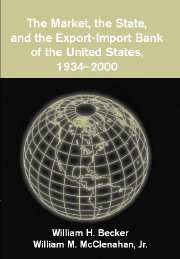Book contents
- Frontmatter
- Contents
- Preface and Acknowledgments
- Introduction
- 1 Setting a Flexible Course: The Export-Import Bank, 1934–1939
- 2 World War and Its Aftermath
- 3 Cold War and the Needs of a New Era, 1948–1961
- 4 Becoming “Two Institutions”
- 5 New Mandates and New Limits
- 6 Turmoil and Turning Points
- 7 A New Era and Its Challenges, the 1990s
- Epilogue
- Appendix A Board of Directors
- Appendix B Summary of Authorizations
- Appendix C Number of Authorizations
- Appendix D Charges Against Statutory Limitations on Total Activity
- Index
2 - World War and Its Aftermath
Published online by Cambridge University Press: 13 July 2009
- Frontmatter
- Contents
- Preface and Acknowledgments
- Introduction
- 1 Setting a Flexible Course: The Export-Import Bank, 1934–1939
- 2 World War and Its Aftermath
- 3 Cold War and the Needs of a New Era, 1948–1961
- 4 Becoming “Two Institutions”
- 5 New Mandates and New Limits
- 6 Turmoil and Turning Points
- 7 A New Era and Its Challenges, the 1990s
- Epilogue
- Appendix A Board of Directors
- Appendix B Summary of Authorizations
- Appendix C Number of Authorizations
- Appendix D Charges Against Statutory Limitations on Total Activity
- Index
Summary
INTRODUCTION
During World War II and in its aftermath, the Export-Import Bank showed itself to be a remarkably flexible and resilient institution. The volume, scope, and complexity of its activity increased rapidly in these years. When war broke out in Europe in 1939, the Bank to that point principally financed the export of surplus agricultural products and aided manufacturers to meet overseas competition. During World War II, the Bank's focus narrowed essentially to dealing with Latin America. But its activities there broadened. It helped Latin American countries to cope with the dislocations in world markets and finance brought about by the conflict. Ex-Im financed – in cooperation at times with other U.S. government agencies – equipment, facilities, and strategic materials for the war effort. The Bank embarked on a program of developmental lending to improve the export capabilities of Latin American countries. In doing so, it reoriented its financing from relatively simple transactions to complex project-type lending that involved literally hundreds or thousands of separate transactions.
Following the war, the U.S. government refocused the Bank on Europe instead of Latin America. In coping with the destruction in Europe, the Ex-Im became the first government agency to provide loans in the emergency reconstruction effort of the immediate postwar years. It was the only agency of the U.S. government still in business in 1945 with the experience to take up the task of extending and managing large credits overseas.
- Type
- Chapter
- Information
- Publisher: Cambridge University PressPrint publication year: 2003



